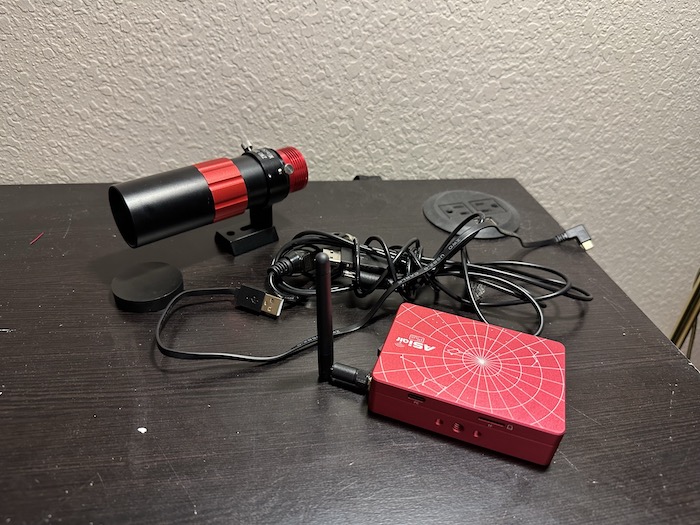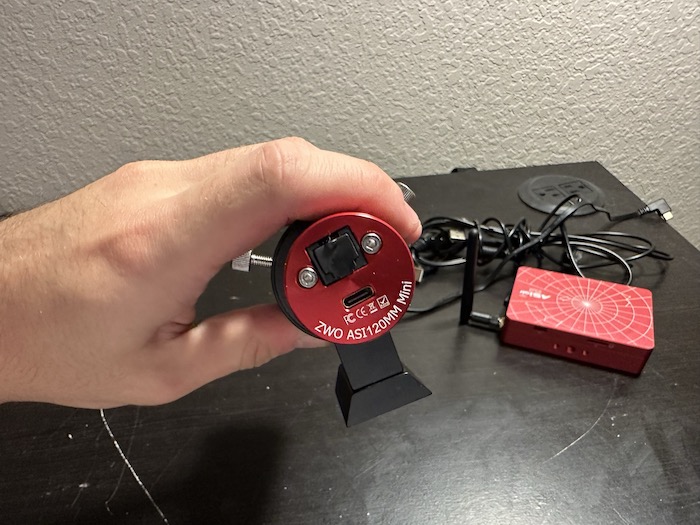The ZWO ASI120MM Mini is one of the newest cameras from CMOS camera powerhouse ZWO. It is based on the company’s ASI1 20MM camera, an inexpensive yet extremely popular camera from ZWO, commonly used for guiding and planetary work that produces high-quality results.
The ASI120mm Mini has some of the 120’s functionality removed but is much cheaper than the non-mini version of this camera. It is designed mostly for deep sky or guiding purposes where not much functionality is needed, and it even has an advantage for those who are using it for autoguiding found in its unique body shape.


Technical Specs of ASI120MM Mini
The ASI120MM Mini uses the same sensor as the 120MM however some of its functionality is reduced, as discussed before. It still shares the same sensor as its predecessor, which I will discuss here.
The tech specs that both cameras share are as follows:
- A CMOS sensor
- The camera includes an AR0130CS CMOS sensor capable of reading out at up to 35 FPS (Mini version). A CMOS sensor is important for cameras like these, along with all planetary cameras as they have high efficiency (closely related to sensitivity), and can read out much faster than their CCD equivalents, which allows for faster video recording and guiding, critical for taking.
- The sensor has a size of ⅓” along the diagonal, which is relatively small for deep-sky cameras but is approximately average for guiding cameras of today which is what you use this camera for. A smaller sensor means that the field of view will be smaller than a larger sensor’s one, but smaller sensors can be fine to use for cameras that are taking photos of things like planets, where you want a smaller image as the planets can be quite small.
- A resolution of 1280×960. This is nothing spectacular like the large sensor models ZWO offers but is to be expected of such a small sensor. This means that you may not be able to show the images taken on a large screen.
- Quantum efficiency of 80%, this is EXCELLENT! The quantum efficiency (or QE) as stated before is similar to the sensitivity of the camera. It dictates how many photons are converted into electrons during a capture. Even cameras like the ASI1600 Pro only have an efficiency of 60%, and CCD Cameras are even lower at around 40%. This means that you will be able to take images with a much shorter exposure time while still picking up adequate light.
What’s new in the Mini?
The ASI120mm Mini, while sharing the same sensor as the 120 is almost completely different from the 120MM.
The differences and new features you may find in this camera include:
- The body is much smaller, in fact only 1.25 inches in diameter until the end of the camera. This means that the entire camera, including sensor, can go further into a 1.25” focuser than other cameras which cut off before the sensor.
- This camera only supports USB 2, instead of 3. This means that the camera is cheaper but it also has some disadvantages. The reasoning behind this will be explained later.
- The camera uses USB-C, which means that its interface is much more modern and future proof compared to almost any other astronomy cameras on the market which use older interfaces. For example, the ASI120MM uses the ancient by comparison USB-B port, which is bulky and hard to find cables for. If you own any modern phone you are likely to own a USB type C cable.
- The camera weighs 60 grams. Because of this, you will not need to worry about balancing the weight of the guide camera if you use a particularly sensitive equatorial mount.
Who would want a camera with reduced functionality?
So, you may ask “why is ZWO selling a camera that only uses USB 2?” and the simple answer to that is for people who are autoguiding. There is no real reason for anyone to use this camera if you are not taking deep sky images or doing autoguiding with it, as for planetary you will be much better off with the non-mini version as it allows you to use a MUCH faster FPS to capture more frames.
For deep-sky and autoguiding purposes, frames per second are not much of a concern as your download times will be much shorter than your exposures, allowing you to use USB 2.0 limited speeds. When your download time becomes longer than your frame rate, such as planetary imaging this limits your maximum FPS. Because guide and deep-sky exposures are on the order of 1 second or longer you are fine to use a camera like this one.
The camera also has a sensor that is quite close to the face of the camera, and the camera body also extends far down. This means when you use something like an off-axis guider setup, you can focus much more easily compared to cameras that have a sensor placed far away from the tube. This is because you have a much larger focusing range than if your sensor is far into the camera.
The extremely sensitive sensor also negates the fact thar at the sensor is ⅓ inches across, because you can pick up dimmer stars in the small area that you have with the sensor. Usually, when you look into a small area of sky you only find dimmer stars, and this can be a problem for insensitive cameras, but now with CMOS technology and the Mini’s sensor finding stars is a non-issue.
Conclusion
To conclude my review of the ZWO ASI120MM Mini, I believe that the camera is highly useful if you are using it for the right reasons, particularly autoguiding. With its extremely sensitive sensor, you are sure to always have stars in the field of view, and its low-profile body allows you to focus inside a wider range. If you plan on buying the camera for planetary work, it is not a good choice, and a camera such as the ASI120MM-c would perform better.
